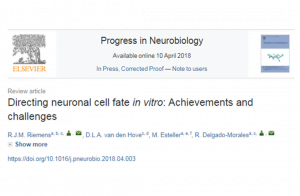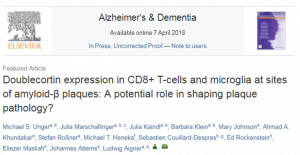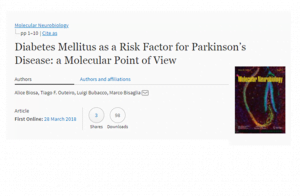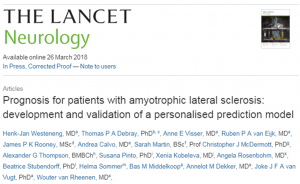 The EU Joint Programme – Neurodegenerative Disease Research (JPND) has awarded funding to ten research projects to perform new network analyses in order to better understand the common underlying mechanisms involved in neurodegenerative diseases.
The EU Joint Programme – Neurodegenerative Disease Research (JPND) has awarded funding to ten research projects to perform new network analyses in order to better understand the common underlying mechanisms involved in neurodegenerative diseases.
Previous research has already shown that similar molecular pathways are relevant in different neurodegenerative and other chronic diseases. With this funding, JPND enables ten multidisciplinary consortia, made up of research teams in 14 countries, to further scrutinise these pathways. This combined analysis of diseases across traditional clinical boundaries, technologies and disciplines could lead to new scientific insights, a re-definition of clinical phenotypes and, ultimately, innovative approaches in the treatment of neurodegenerative diseases.
“The recent failures of a number of clinical trials for Alzheimer’s disease make clear that we are still far from fully understanding the biological underpinnings of neurodegenerative diseases,” said JPND Chair Professor Philippe Amouyel. “The ten world-class consortia selected for funding in this call bring together skills and knowledge from across different disciplines and countries. They are poised to open collaborative new investigations into the fundamental mechanisms that we see in multiple diseases but that we don’t yet understand. We hope that this research will result in new hypotheses that could lead to the next generation of therapeutic approaches.”
The ten projects were recommended for funding by an independent, international Peer Review Panel based on scientific excellence.
Click on the links below to learn more about each project supported under JPND’s 2017 Pathway Analysis call.
BRAIN-MEND: Biological Resource Analysis to Identify New Mechanisms and phenotypes in Neurodegenerative Diseases
Coordinator:
Ammar Al-Chalabi, King’s College London, King’s Clinical Neuroscience Institute, London, UK
Partners:
Naomi Wray, University of Queensland, Brisbane, QLD, Australia
Gilbert Bensimon, Centre Hospitalier Universitaire de Nîmes, Nîmes, France
Orla Hardiman, Trinity College Dublin, Ireland
Adriano Chio, University of Turin, Italy
Jan Veldink, University Medical Center, Utrecht, Netherlands
EpiAD: Effect of early and adult-life stress on the brain epigenome: relevance for the occurrence of Alzheimer’s Disease and Diabetes-related dementia
Coordinator:
Johannes Gräff, Brain Mind Institute, School of Life Sciences, Ecole Polytechnique Fédérale Lausanne, Switzerland
Partners:
Froylan Calderon de Anda, Center for Molecular Neurobiology Hamburg, Hamburg, Germany
Ana Frank-Garcia, Department of Neurology, University Hospital La Paz, Madrid, Spain
Agnieszka Basta-Kaim, Institute of Pharmacology, Polish Academy of Sciences, Krakow, Poland
HEROES: The locus coeruleus: at the crossroad of dementia syndromes
Coordinator:
Mara Dierssen, Instituto Hospital del Mar de Investigaciones Mèdicas (IMIM), Barcelona, Spain
Partners:
Yann Herault, Institut de Génétique Biologie Moléculaire et Cellulaire (IGBMC), Illkirch-Graffenstaden, France
Marie-Claude Potier, Institut du Cerveau et de la Moëlle Epinière (ICM), Paris, France
Peter Paul De Deyn, University Medical Center Groningen (UMCG), The Netherlands
André Strydom, University College London (UCL), United Kingdom
localMND: Common architecture of local proteome, transcriptome and translatome across Motor Neuron disorders
Coordinator:
Marina Chekulaeva, Berlin Institute for Medical Systems Biology, Berlin, Germany
Partners:
Igor Ulitsky, Weizmann Institute of Science, Rehovot, Israel
Vincenzo La Bella, Department of Experimental BioMedicine and Clinical Neurosciences, University of Palermo, Palermo, Italy
Erik Storkebaum, Department of Molecular Neurobiology, Radboud University, Nijmegen, the Netherlands
LODE: Loss of neurotrophic factors in neurodegenerative Dementias: Back to the crossroads of proteins
Coordinator:
Roberta Ghidoni, IRCCS Centro San Giovanni di Dio Fatebenefratelli, Brescia, Italy
Partners:
Giuseppe Di Fede, Foundation IRCCS Carlo Besta Neurological Institute, Milan, Italy
Katharina Landfester, Max Planck Institute for Polymer Research, Mainz, Germany
Maria Grazia Spillantini, University of Cambridge, Cambridge, UK
NEURONODE: Systems Analysis of Key Nodes in Neurodegenerative Diseases
Coordinator:
Peter McCormick, Queen Mary University of London, United Kingdom
Partners:
Nicolas Locker, University of Surrey, United Kingdom
Carl Ernst, McGill University, Canada
Stephane Lefrancois, Institut National de la Recherche Scientifique, Laval, Canada
Andreas Schuppert, RWTH Aachen University, Germany
Andrew Ewing, University of Gothenburg, Sweden
Protest-70: Protecting protein homeostasis in synucleinopathies and tauopathies by modulating the Hsp70/co-chaperone network
Co-Coordinators:
Carmen Nußbaum-Krammer, Center for Molecular Biology of Heidelberg University (ZMBH) and German Cancer Research Center (DKFZ), Heidelberg, Germany
Bernd Bukau, Center for Molecular Biology of Heidelberg University (ZMBH) and German Cancer Research Center (DKFZ), Heidelberg, Germany
Partners:
Ronald Melki, Paris-Saclay Institute of Neuroscience, CNRS, France
Harm Kampinga, Faculty of Medical Sciences, University of Groningen, Netherlands
Christian Hansen, Faculty of Medicine, Lund University, Sweden
RNA-NEURO: Systems Analysis of novel small non-coding RNA in neuronal stress responses: towards novel biomarkers and therapeutics for neurodegenerative disorders
Coordinator:
Jochen Prehn, Royal College of Surgeons in Ireland, RCSI Centre for Systems Medicine, Dublin, Ireland
Partners:
Ruth Slack, University of Ottawa, Canada
Jørgen Kjems, Aarhus University, Denmark
Mark Helm, University of Mainz, Germany
Giovanni Nardo, IRCCS-Mario Negri Institute, Milan, Italy
Michael Adriaan van Es, University Medical Center, Utrecht, Netherlands
TransNeuro: Altered mRNA translation as a pathogenic mechanism across neurodegenerative diseases
Coordinator:
Erik Storkebaum, Donders Institute for Brain, Cognition and Behaviour, Radboud University, Nijmegen, Netherlands
Partners:
Nahum Sonenberg, McGill University, Montreal, Canada
Marie-Christine Chartier-Harlin, Inserm UMRS1172, Lille, France
Erin Schuman, Max Planck Institute for Brain Research, Frankfurt, Germany
Kobi Rosenblum, University of Haifa, Haifa, Israel
Giovanna Mallucci, University of Cambridge, Cambridge, UK
TransPathND: Intraneuronal transport-related pathways across neurodegenerative diseases
Coordinator:
Michel Simonneau, Laboratoire Aimé Cotton, ENS Paris-Saclay, Orsay, France
Partners:
Ronald Melki, Paris-Saclay Institute of Neuroscience, CNRS, Gif-sur-Yvette, France
August B. Smit, Center for Neurogenomics and Cognitive Research, VU University Amsterdam, Netherlands
Nicolas Le Novere, Babraham Institute, Cambridge, United Kingdom





